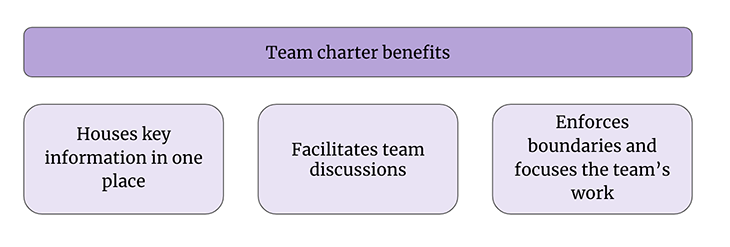Working collaboratively and purposefully as a team is a key ingredient for any successful tech company. Part of what helps a team work collaboratively together is creating a sense of unified purpose and mission — a singular objective that the whole team understands and can work towards with each other.

Without understanding and supporting a singular purpose or mission, a team can break apart or drift away from the mission.
As a product manager, it is your responsibility to shape the team’s key mission and objectives. Your role is also to explain and unify team members behind the “why,” aka the reason the key mission and objectives exist in the first place. Being clear and concise with what you want to achieve with the team, as well as why you want to achieve it, helps drive the team towards completing initiatives that are aligned with your product and company’s mission.
An effective way in driving collaboration and a unified purpose within the team is by using a team charter. In this article, we will explore what a team charter is, its key benefits, and the components of a successful team charter. I’ll also give you a free team charter template for you to use and customize as needed. Let’s get started!
The team charter underpins the formation and continued existence of any team within a company. The charter is a document that helps align different personalities, skill sets, and expectations of members within the team. It also provides direction to the team, not only in terms of the “what” and “why” the team’s working on certain initiatives, but also the values and rituals of the team.
By having a team charter, teams can have more focus and direction. The document clearly spells out exactly what the team will and won’t be working on in both the short and long term. Additionally, most team charters are a collaborative effort between members and leaders of the team, making it a document that everyone can agree on. This helps foster a sense of authenticity and genuiness in the team charter — something that can be relied upon by both members of the team and other internal members of the company.
Think of the team charter as an instruction booklet or manual. It helps the team understand their roles and responsibilities and how each of them helps contribute to the wider goals of the product and the company.
The following are the key benefits of having a team charter:

As mentioned above, having a team charter not only helps detail the “what” and “why” of the tasks, but also keeps it all in a single, transparent, and easily-accessible spot that everyone in the company can access.
Since the team charter is a document everyone on the team can collaborate on, it becomes an ideal place for either sync or async discussions. Examples include discussions between team members about each other’s roles and responsibilities, the values of the team, as well as the understanding of the scope and depth of the mission/objectives of the team.
By having discussions around the mission and objectives of the team, a team charter helps put a “fence” around the potential work that the team will undertake. It ensures that everyone will be focusing on the most relevant, high-value work that helps the team achieve its mission and goals.
The team charter helps provide a singular mindset rather than keeping members on different paths that diverge from the shared mission or objective.
The following are some of the key components of a team charter:
Start your team charter off by listing the exact mission or objective the team is meant to achieve. This should be a 1–2 line statement that clearly and succinctly explains the reason for the existence of your team.
For example, this can be the objective for which key results will be measured against (e.g., OKRs) or a more philosophical statement that more broadly encompasses what you hope to achieve together for the product and the company.
This section should include profiles of the members of your team, including their names, role, responsibilities, and whether they are part of the leadership group (for example, the product trio).
Listing down the members of your team and the role that they play helps inform internal stakeholders within the company about who they can ask certain questions to.
For example, if someone has a question about the kind of work the team is doing, they can locate a leadership team member by simply looking at the team charter.
Flowing from the above point, it’s important that the team charter specifies which members of the team form the leadership group (or product trio) for the team. This helps identify the communication funnel and the individuals that the burden of success or failure falls on.
Other than identifying the leadership group, this section should also spell out the different types of communication methods to access the team, like email, Slack, text, etc.
This is one of the most crucial sections of your team charter and forms the yardstick for success. The team has to agree on what exactly they’re setting out to achieve and why they are doing so.
Here, the goals differ from the mission and objectives. Goals are practical work that needs to be completed successfully by the team, together, to fully realize the full value of the mission in the short and long term.
However, it is more common for this section to be a little bit more direct in terms of the actual initiatives that feed into the goals. You don’t want to be too broad and sound eerily similar to the mission statement that starts off the document.
In this section, you want to collaborate, discuss, and agree with your team members on the exact methods, frameworks, and structures of work. These can be already existing or ones that you would like to put into place to help the team maximize productivity.
These discussions will cover things like workflow structure (such as full agile sprints or simple Kanban board process), occurrence and regularity of several team rituals (such as standups, retros, and more), as well as incident escalation and risk management processes.
By collaborating and agreeing with your team members on the exact methods, frameworks, and rituals moving forward, you’ll help gel the team together and get more tacit support.
This part of the team charter details the ownership map of the team — the features, functions, workflows, or infrastructure of the product that your team will own.
For example, if your team is responsible for the onboarding process of your product’s users, it might make sense for your team to own the signup journey or the login pages of your product.
As is the case with any sort of work your team is committing to do, there is also an aspect of work they commit to not doing in the first place.
By having the team collaboratively discuss what’s within their wheelhouse of work and what’s not, you’ll get a clearer picture for all members of the team. It also helps narrow the focus to things that are most pertinent and important to the achievement of the mission.
Last but not least, it is good to host a discussion around the attributes each member expects from the team as they move forward — whether that be an open communication culture, transparency around issues, an expectation to resolve issues quickly, or honesty with each other when team members are stuck.
By highlighting and underlining the key core values and non-negotiables that the team expects, members will understand each other better and make sure that they all understand the ground rules of what makes a good team tick.
There are lots of formats you can put a team charter in, but I find it’s easier to keep it simple. To help you get started, please feel free to download the following free team charter template from Google Docs! You can make a copy to your Google account and customize it as needed.
Follow the tips above and you’ll be creating your very own team charter in no time! If you would like to see other templates that I’ve created for product managers, please feel free to visit this link to my website as well.
Featured image source: IconScout
LogRocket identifies friction points in the user experience so you can make informed decisions about product and design changes that must happen to hit your goals.
With LogRocket, you can understand the scope of the issues affecting your product and prioritize the changes that need to be made. LogRocket simplifies workflows by allowing Engineering, Product, UX, and Design teams to work from the same data as you, eliminating any confusion about what needs to be done.
Get your teams on the same page — try LogRocket today.

Christina Valls shares how her teams have transformed digital experiences at Cedars-Sinai, including building a digital scheduling platform.

Red-teaming reveals how AI fails at scale. Learn to embed adversarial testing into your sprints before your product becomes a headline.

Cory Bishop talks about the role of human-centered design and empathy in Bubble’s no-code AI development product.

Learn how to reduce mobile friction, boost UX, and drive engagement with practical, data-driven strategies for product managers.